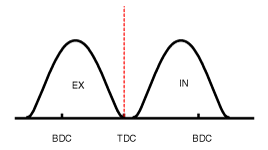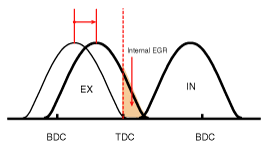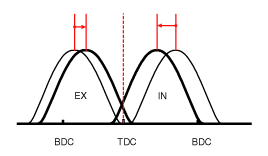Kia Cadenza: Cylinder Head Assembly / CVVT & Camshaft Description and Operation
Kia Cadenza YG 2016-2025 Service Manual / Engine Mechanical System / Cylinder Head Assembly / CVVT & Camshaft Description and Operation
| Description |
Continuous Variable Valve Timing (CVVT) system advances or
retards the valve timing of the intake and exhaust valve in accordance
with the ECM control signal which is calculated by the engine speed and
load.
By controlling CVVT, the valve over-lap or under-lap occurs,
which makes better fuel economy and reduces exhaust gases (NOx, HC).
CVVT improves engine performance through reduction of pump loss,
internal EGR effect, improvement of combustion stability, improvement of
volumetric efficiency, and increase of expansion work.
This system consist of
| – |
the CVVT Oil Control Valve (OCV) which supplies the engine
oil to the cam phaser or runs out the engine oil from the cam phaser in
accordance with the ECM PWM (Pulse With Modulation) control signal, |
| – |
the CVVT Oil Temperature Sensor (OTS) which measures the engine oil temperature, |
| – |
and the Cam Phaser which varies the cam phase by using the hydraulic force of the engine oil. |
The engine oil released out of the CVVT oil control valve
varies the cam phase in the direction (Intake Advance/Exhaust Retard) or
opposite direction (Intake Retard/Exhaust Advance) of the engine
rotation by rotating the rotor connected with the camshaft inside the
cam phaser.

| Operation Principle |
The CVVT has the mechanism rotating the rotor vane with
hydraulic force generated by the engine oil supplied to the advance or
retard chamber in accordance with the CVVT oil control valve control.
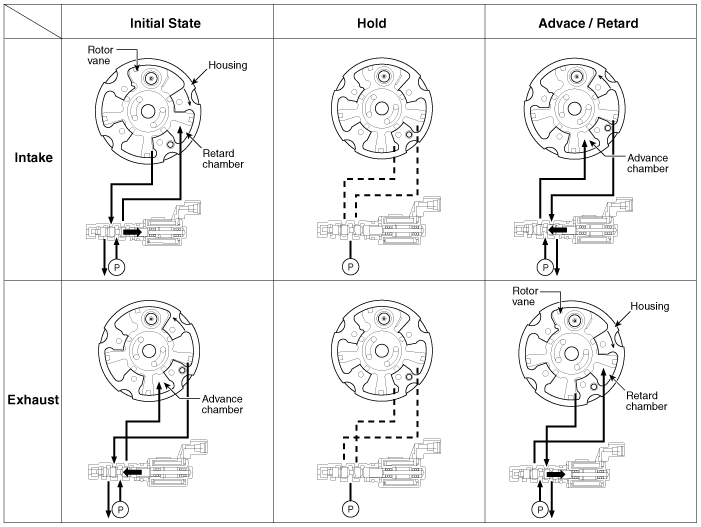
| [CVVT System Mode] |
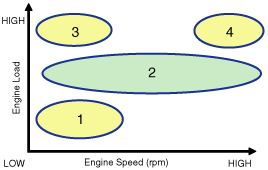
| (1) Low Speed / Low Load | (2) Part Load |
|
|
| (3) Low Speed / High Load | (4) High Speed / High Load |
|
|
| Driving Condition | Exhaust Valve | Intake Valve | ||
| Valve Timing | Effect | Valve Timing | Effect | |
| (1) Low Speed /Low Load | Completely Advance | * Valve Under-lap * Improvement of combustion stability | Completely Retard | * Valve Under-lap * Improvement of combustion stability |
| (2) Part Load | Retard | * Increase of expansion work * Reduction of pumping loss * Reduction of HC | Retard | * Reduction of pumping loss |
| (3) Low Speed /High Load | Retard | * Increase of expansion work | Advance | * Prevention of intake back flow (Improvement of volumetric efficiency) |
| (4) High Speed /High Load | Advance | * Reduction of pumping loss | Retard | * Improvement of volumetric efficiency |
 CVVT & Camshaft Components and Components Location
CVVT & Camshaft Components and Components Location
Components
1. RH exhaust camshaft2. RH intake camshaft3. LH intake camshaft4. LH exhaust camshaft
1. RH exhaust CVVT2. RH intake CVVT3. LH intake CVVT4. LH exhaust CVVT
...
 CVVT & Camshaft Repair procedures
CVVT & Camshaft Repair procedures
Removal
Continuous Variable Valve Timing (CVVT)
1.
Remove the timing chain.
(Refer to Timing System - "Timing Chain")
2.
Remove the CVVT assembly.
•
A: LH exhaust CVVT
•
...
Other information:
Kia Cadenza YG 2016-2025 Owners Manual: Heated steering wheel
With the ENGINE START/STOP button in the ON position, pressing the heated steering wheel button warms the steering wheel. The indicator on the button will illuminate. To turn the heated steering wheel off, press the button once again. The indicator on the button will turn off. WARNIN ...
Kia Cadenza YG 2016-2025 Service Manual: Specifications
Specification Engine & T/MJoint typeMax. permissible angleInnerOuterInnerOuterLambda 3.3 GDIVTJ#25BJ#2621°46.5° Tightening Torques ItemN.mkgf.mIb-ftFrontWheel nut88.2 ~ 107.89.0 ~ 11.065.0 ~ 79.5Drive shaft coking nut274.6 ~ 294.228.0 ~ 30.0202.5 ~ 217.0Strut assembly lower mounting ...
Copyright © www.kcadenzavg.com 2017-2025


